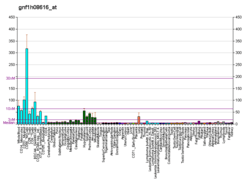PREX1
Phosphatidylinositol 3,4,5-trisphosphate-dependent Rac exchanger 1 protein is a protein that in humans is encoded by the PREX1 gene.[5][6][7][8]
Function
The protein encoded by this gene acts as a guanine nucleotide exchange factor for the RHO family of small GTP-binding proteins (RACs). It has been shown to bind to and activate RAC1 by exchanging bound GDP for free GTP. The encoded protein, which is found mainly in the cytoplasm, is activated by phosphatidylinositol-3,4,5-trisphosphate and the beta-gamma subunits of heterotrimeric G proteins.[8]
Clinical significance
The protein has been implicated in the spread of melanoma skin cancer.[9]
References
- 1 2 3 GRCh38: Ensembl release 89: ENSG00000124126 - Ensembl, May 2017
- 1 2 3 GRCm38: Ensembl release 89: ENSMUSG00000039621 - Ensembl, May 2017
- ↑ "Human PubMed Reference:".
- ↑ "Mouse PubMed Reference:".
- ↑ Welch HC, Coadwell WJ, Ellson CD, Ferguson GJ, Andrews SR, Erdjument-Bromage H, Tempst P, Hawkins PT, Stephens LR (Apr 2002). "P-Rex1, a PtdIns(3,4,5)P3- and Gbetagamma-regulated guanine-nucleotide exchange factor for Rac". Cell. 108 (6): 809–21. doi:10.1016/S0092-8674(02)00663-3. PMID 11955434.
- ↑ Hill K, Krugmann S, Andrews SR, Coadwell WJ, Finan P, Welch HC, Hawkins PT, Stephens LR (Feb 2005). "Regulation of P-Rex1 by phosphatidylinositol (3,4,5)-trisphosphate and Gbetagamma subunits". J Biol Chem. 280 (6): 4166–73. doi:10.1074/jbc.M411262200. PMID 15545267.
- ↑ Mayeenuddin LH, Garrison JC (Jan 2006). "Phosphorylation of P-Rex1 by the cyclic AMP-dependent protein kinase inhibits the phosphatidylinositiol (3,4,5)-trisphosphate and Gbetagamma-mediated regulation of its activity". J Biol Chem. 281 (4): 1921–8. doi:10.1074/jbc.M506035200. PMID 16301320.
- 1 2 "Entrez Gene: PREX1 phosphatidylinositol 3,4,5-trisphosphate-dependent RAC exchanger 1".
- ↑ Lindsay CR, Lawn S, Campbell AD, et al. (2011). "P-Rex1 is required for efficient melanoblast migration and melanoma metastasis". Nature Communications. 2: 555. doi:10.1038/ncomms1560. PMC 3400057. PMID 22109529. Lay summary – Cancer Research UK.
Further reading
- Nakajima D, Okazaki N, Yamakawa H, et al. (2003). "Construction of expression-ready cDNA clones for KIAA genes: manual curation of 330 KIAA cDNA clones". DNA Res. 9 (3): 99–106. doi:10.1093/dnares/9.3.99. PMID 12168954.
- Nagase T, Kikuno R, Ishikawa KI, et al. (2000). "Prediction of the coding sequences of unidentified human genes. XVI. The complete sequences of 150 new cDNA clones from brain which code for large proteins in vitro". DNA Res. 7 (1): 65–73. doi:10.1093/dnares/7.1.65. PMID 10718198.
- Wiemann S, Weil B, Wellenreuther R, et al. (2001). "Toward a catalog of human genes and proteins: sequencing and analysis of 500 novel complete protein coding human cDNAs". Genome Res. 11 (3): 422–35. doi:10.1101/gr.GR1547R. PMC 311072. PMID 11230166.
- Fossey SC, Mychaleckyj JC, Pendleton JK, et al. (2001). "A high-resolution 6.0-megabase transcript map of the type 2 diabetes susceptibility region on human chromosome 20". Genomics. 76 (1–3): 45–57. doi:10.1006/geno.2001.6584. PMID 11549316.
- Deloukas P, Matthews LH, Ashurst J, et al. (2002). "The DNA sequence and comparative analysis of human chromosome 20". Nature. 414 (6866): 865–71. doi:10.1038/414865a. PMID 11780052.
- Weiner OD (2002). "Rac activation: P-Rex1 - a convergence point for PIP(3) and Gbetagamma?". Curr. Biol. 12 (12): R429–31. doi:10.1016/S0960-9822(02)00917-X. PMC 2819105. PMID 12123595.
- Strausberg RL, Feingold EA, Grouse LH, et al. (2003). "Generation and initial analysis of more than 15,000 full-length human and mouse cDNA sequences". Proc. Natl. Acad. Sci. U.S.A. 99 (26): 16899–903. doi:10.1073/pnas.242603899. PMC 139241. PMID 12477932.
- Ota T, Suzuki Y, Nishikawa T, et al. (2004). "Complete sequencing and characterization of 21,243 full-length human cDNAs". Nat. Genet. 36 (1): 40–5. doi:10.1038/ng1285. PMID 14702039.
- Gerhard DS, Wagner L, Feingold EA, et al. (2004). "The status, quality, and expansion of the NIH full-length cDNA project: the Mammalian Gene Collection (MGC)". Genome Res. 14 (10B): 2121–7. doi:10.1101/gr.2596504. PMC 528928. PMID 15489334.
- Zhao T, Nalbant P, Hoshino M, et al. (2007). "Signaling requirements for translocation of P-Rex1, a key Rac2 exchange factor involved in chemoattractant-stimulated human neutrophil function". J. Leukoc. Biol. 81 (4): 1127–36. doi:10.1189/jlb.0406251. PMID 17227822.
- Ewing RM, Chu P, Elisma F, et al. (2007). "Large-scale mapping of human protein-protein interactions by mass spectrometry". Mol. Syst. Biol. 3 (1): 89. doi:10.1038/msb4100134. PMC 1847948. PMID 17353931.
- Hernández-Negrete I, Carretero-Ortega J, Rosenfeldt H, et al. (2007). "P-Rex1 links mammalian target of rapamycin signaling to Rac activation and cell migration". J. Biol. Chem. 282 (32): 23708–15. doi:10.1074/jbc.M703771200. PMID 17565979.
- Barber MA, Donald S, Thelen S, et al. (2007). "Membrane translocation of P-Rex1 is mediated by G protein betagamma subunits and phosphoinositide 3-kinase". J. Biol. Chem. 282 (41): 29967–76. doi:10.1074/jbc.M701877200. PMID 17698854.
This article is issued from
Wikipedia.
The text is licensed under Creative Commons - Attribution - Sharealike.
Additional terms may apply for the media files.




